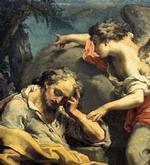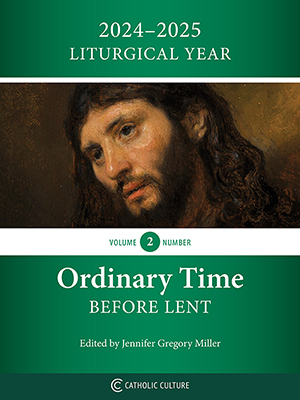The Father William Most Collection
Date of Birth of Christ
[Published electronically for use in classes taught by Fr. Most and for private theological study.]
(Summarized from E. L. Martin, The Star that Astonished the World, ASK Publications.)
Herod's Death and Eclipse of the Moon
The date of the birth of Christ hinges on just one thing, the statement of Josephus (Antiquities 17. 6-8) that Herod died shortly after an eclipse of the moon. Astronomers supply the dates for such eclipses around those years: None in 7 or 6 BC. In 5 BC, March 23: 29 days to Passover. Also in 5 BC, Sept 15: 7 months to Passover. In 4 BC, March 13: 29 days to Passover. In 3 and 2 BC, no eclipses. In 1 BC, January 10: 12 1/2 weeks to Passover.
Josephus also tells what events happened between the Eclipse and the Passover (cf. Martin pp. 85-87). They would occupy probably about 12 weeks. Martin also, pp. 99-101, shows that the eclipse of Sept 15, 5 BC could not fit with known data, especially the fact that Herod was seriously ill in Jericho (over 800 feet below sea level) when the eclipse happened - but Jericho was a furnace of heat at that time, Sept 15. Herod would not have stayed there when he could have had the much better climate of Jerusalem. But if the eclipse was in midwinter -- Jan 10 -- Herod would find Jericho comfortable.
So Herod died in 1 BC, and the birth of Christ cannot be put too much earlier than that.
The Census
We know from an inscription from Paphlagonia in Asia Minor -- cf. Lewis and Reinhold, Roman Civilization, Source Book II, pp. 34-35 -- that in 3 BC all the people took an oath of allegiance to Augustus. The same oath is also reported by the Armenian historian Moses of Khorene, and by the later historian Orosius.
Augustus was to receive the great title of Pater Patriae on Feb. 5, 2 BC. So the actual governor of Palestine, probably Varus, would have had to go to Rome for the festivities, and since sailing on the Mediterranean stopped about Nov. 1, and did not resume until Spring, he must have gone in the early fall of 3 BC. But Quirinius was nearby, had just finished a successful war against the Homonadenses. So he was left as acting Governor. Luke does not use the noun governor, but the participle, "governing".
So Christ was born in 3 BC, during registration for the oath, after Varus had left for Rome.
Solving obscurities
There is an obscure decade in history, 6 BC to 4 AD, as Classicists readily recognize. Yet this period is important, including the time when Tiberius was absent from political life at Rome, being at Capri. It is hard to fit the events of this period into place if we make the birth of Christ early as is commonly done. But if we put it in 3 BC the difficulties are over. For example, we know Augustus received his 15th acclamation for a major victory, won by one of his generals, around this time. If we pick 4 BC for the death of Herod, we cannot find a victory to warrant the acclamation, which came in 1 AD. But if we put the birth of Christ in 3 BC, then the war would be running at about the needed time, and finished in 1 AD.
Objection 1: Josephus gives two indications of the length of the rule of Herod: A) He says Herod had a reign of 37 years from the time he was proclaimed king by the Romans and; B) 34 years after the death of Antigonus, which happened just after Herod took Jerusalem.
These would make the death of Herod come in 3 BC. But there was no eclipse of the moon in that year. Nearest one was March 13, 4 BC- - so scholars said they had stretch the statements of Josephus.
Reply to objection 1: Herod took Jerusalem late in 36 BC. Josephus says Herod's siege of Jerusalem was during a sabbatical year, and 36 was a sabbatical year. Otherwise would need to be 7 years before or after 36. Also, all sabbatical years ended on Yom Kippur. Josephus said Herod's capture of Jerusalem coincided with Yom Kippur. He and the Jews would remember it well, for it was an outrage to press a siege on Yom Kippur. Josephus said it was 27 years to the day that Pompey committed his abominations, which he did in 63 BC. This gives again 36 BC for Herod's capture of Jerusalem. If we use the common accession method of counting years of rule, the date to start his 34 years is the first of Nisan in 35 BC. So Herod's 34th year of rule would start with the 1st of Nisan in 2 BC. and end with first of Nisan in 1 BC. Now 34 years after 35 BC would give 1 BC for the death and end of the reign of Herod, his death, soon after the eclipse of Jan 10, 1 BC.
Objection 2: Herod's three successors, Archelaus, Antipas, and Philip, seem to have their reigns starting in 4 BC.
Reply to objection 2: Herod had two sons, Alexander and Aristobulus by Mariamme, a Hasmonean. They were popular with the people, but Herod had designated Antipater his oldest son as his successor, who saw the 2 sons, Alexander and Aristobulus as a threat to him -- so he made false charges, led Herod to have them executed. Antipater became co-ruler with Herod in 4 BC. But Antipater plotted to kill Herod, who found out, had him executed in 4 BC.
Archelaus and Antipas were sons of Herod by Malthace, a Samaritan. Philip was a son by Cleopatra of Jerusalem. Archelaus, Antipas and Philip counted their reigns as starting also in 4 BC. However, antedating reigns was common, as coins show, and Herod gave his kingdom to them before his death. It was tactical to antedate the reigns of these three to the death of the two "royal" sons, Alexander and Aristobulus, who were of Hasmonean descent, so that Archelaus, Antipas and Philip would seem successors to these two.
This reason was intensified by the fact that Herod had been demoted by Augustus in 4 BC. Herod had sent troops to Arabia to end activities of robbers and to collect a large debt owed him by the Arabian ruler. Syllaeus the Arabian misinformed Augustus about Herod's actions--Herod really had permission from the governors of Syria for that. Augustus wrote to Herod: "Whereas of old he [Augustus] had used him as his friend, he should now use him as his subject." This was politically devastating. He had to have Caesar's representatives for Syria hear the case against Alexander and Aristobulus and the trial was held in Beirut. Later before executing Antipater, Varus governor of Syria heard the case. Also in 4 BC began the joint rule of Antipater with Herod.
The Star
In the evening of June 17, 2 BC, there was a spectacular astronomical event in the western sky. Venus moved eastward seemingly going to collide with Jupiter. They appeared as one star, not two, dominating the twilight of the western sky in the direction of Palestine. This conjunction had not happened for centuries, would not happen again for more centuries. Jupiter was considered the Father, Venus the Mother. Then not many days later, Venus came within .36 degrees of Mercury. On Sept 11 came the New Moon, the Jewish New Year. This happened when Jupiter, the King planet was approaching Regulus, the King star. Further, there were three conjunctions of Jupiter and Regulus within the constellation of Leo, the lion which was considered the head of the Zodiac. Now Gen 49:10 had foretold there would always be a ruler from Judah, whom Jacob called the lion, until the time of the Messiah. Leo was dominated by the star Regulus, which astronomers called the King Star. The Magi, being astronomers and astrologers, would surely read these signs. (The three conjunctions with Regulus were Aug 12, 3 BC; Feb. 17, 2 BC, and May 8/9 2BC). In Hebrew Jupiter was called sedeq, righteous, a term specially pertaining to the Messiah.
On Sept 11, Jupiter was close in the constellation of Virgo, the virgin. On Sept 3 of 3 BC Jupiter was in conjunction with Regulus, the brightest star in the constellation of Leo--Leo the Lion, which was associated with Kings, and the Lion of Judah, as foretold by the dying Jacob in Egypt in Genesis 49. 10.
Also, on Dec. 25 of 2 BC, Jupiter stopped for 6 days over Bethlehem. This is a normal motion for Jupiter, it stops twice, and reverses its seeming movement. This may have been the very time the Magi came with their gifts. This was also the time of the Hanukkah festival, during which it was customary for Jewish Fathers to give gifts to their children.
The shepherds watching their flocks in the fields indicates a date either in late summer or early fall.
Martin thinks the birth of Jesus was in September 3 BC, and the probable date of the Magi was Dec. 25, 2 BC.
More than 600 planetariums here and in Europe have revised their Christmas star show to match this work of E. L. Martin.
Magi were not really just astrologers. They served as court advisors, going from one royal court to another. It would not then be difficult to suppose they had come from a great distance with gifts. In those days all astronomers were acquainted with astrology. They were also mathematicians.






